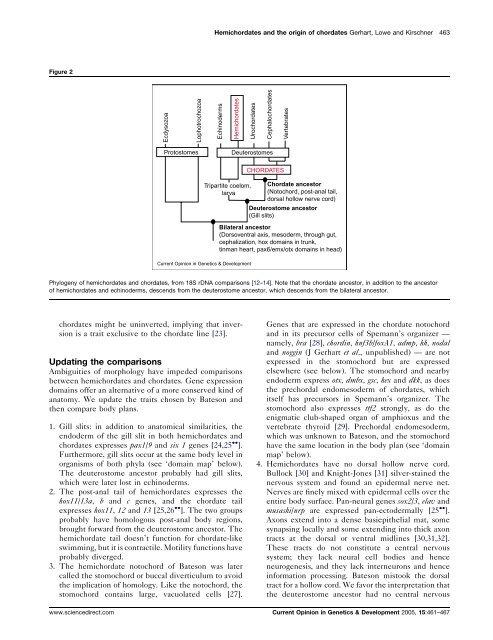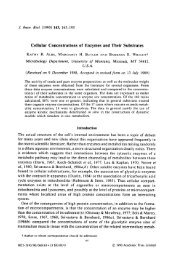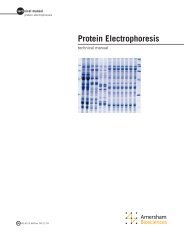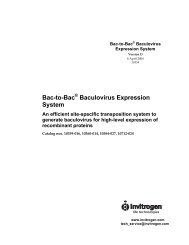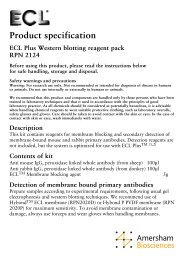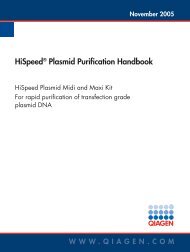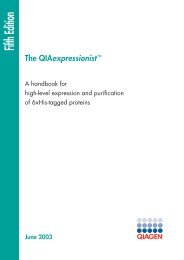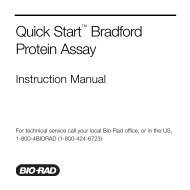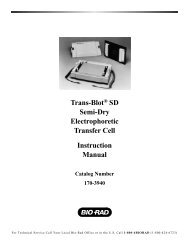Hemichordates and the origin of chordates
Hemichordates and the origin of chordates
Hemichordates and the origin of chordates
You also want an ePaper? Increase the reach of your titles
YUMPU automatically turns print PDFs into web optimized ePapers that Google loves.
<strong>Hemi<strong>chordates</strong></strong> <strong>and</strong> <strong>the</strong> <strong>origin</strong> <strong>of</strong> <strong>chordates</strong> Gerhart, Lowe <strong>and</strong> Kirschner 463<br />
Figure 2<br />
Ecdysozoa<br />
Lophotrochozoa<br />
Echinoderms<br />
<strong>Hemi<strong>chordates</strong></strong><br />
Uro<strong>chordates</strong><br />
Cephalo<strong>chordates</strong><br />
Vertebrates<br />
Protostomes<br />
Deuterostomes<br />
Tripartite coelom,<br />
larva<br />
CHORDATES<br />
Chordate ancestor<br />
(Notochord, post-anal tail,<br />
dorsal hollow nerve cord)<br />
Deuterostome ancestor<br />
(Gill slits)<br />
Bilateral ancestor<br />
(Dorsoventral axis, mesoderm, through gut,<br />
cephalization, hox domains in trunk,<br />
tinman heart, pax6/emx/otx domains in head)<br />
Current Opinion in Genetics & Development<br />
Phylogeny <strong>of</strong> hemi<strong>chordates</strong> <strong>and</strong> <strong>chordates</strong>, from 18S rDNA comparisons [12–14]. Note that <strong>the</strong> chordate ancestor, in addition to <strong>the</strong> ancestor<br />
<strong>of</strong> hemi<strong>chordates</strong> <strong>and</strong> echinoderms, descends from <strong>the</strong> deuterostome ancestor, which descends from <strong>the</strong> bilateral ancestor.<br />
<strong>chordates</strong> might be uninverted, implying that inversion<br />
is a trait exclusive to <strong>the</strong> chordate line [23].<br />
Updating <strong>the</strong> comparisons<br />
Ambiguities <strong>of</strong> morphology have impeded comparisons<br />
between hemi<strong>chordates</strong> <strong>and</strong> <strong>chordates</strong>. Gene expression<br />
domains <strong>of</strong>fer an alternative <strong>of</strong> a more conserved kind <strong>of</strong><br />
anatomy. We update <strong>the</strong> traits chosen by Bateson <strong>and</strong><br />
<strong>the</strong>n compare body plans.<br />
1. Gill slits: in addition to anatomical similarities, <strong>the</strong><br />
endoderm <strong>of</strong> <strong>the</strong> gill slit in both hemi<strong>chordates</strong> <strong>and</strong><br />
<strong>chordates</strong> expresses pax1/9 <strong>and</strong> six 1 genes [24,25 ].<br />
Fur<strong>the</strong>rmore, gill slits occur at <strong>the</strong> same body level in<br />
organisms <strong>of</strong> both phyla (see ‘domain map’ below).<br />
The deuterostome ancestor probably had gill slits,<br />
which were later lost in echinoderms.<br />
2. The post-anal tail <strong>of</strong> hemi<strong>chordates</strong> expresses <strong>the</strong><br />
hox11/13a, b <strong>and</strong> c genes, <strong>and</strong> <strong>the</strong> chordate tail<br />
expresses hox11, 12 <strong>and</strong> 13 [25,26 ]. The two groups<br />
probably have homologous post-anal body regions,<br />
brought forward from <strong>the</strong> deuterostome ancestor. The<br />
hemichordate tail doesn’t function for chordate-like<br />
swimming, but it is contractile. Motility functions have<br />
probably diverged.<br />
3. The hemichordate notochord <strong>of</strong> Bateson was later<br />
called <strong>the</strong> stomochord or buccal diverticulum to avoid<br />
<strong>the</strong> implication <strong>of</strong> homology. Like <strong>the</strong> notochord, <strong>the</strong><br />
stomochord contains large, vacuolated cells [27].<br />
Genes that are expressed in <strong>the</strong> chordate notochord<br />
<strong>and</strong> in its precursor cells <strong>of</strong> Spemann’s organizer —<br />
namely, bra [28], chordin, hnf3b/foxA1, admp, hh, nodal<br />
<strong>and</strong> noggin (J Gerhart et al., unpublished) — are not<br />
expressed in <strong>the</strong> stomochord but are expressed<br />
elsewhere (see below). The stomochord <strong>and</strong> nearby<br />
endoderm express otx, dmbx, gsc, hex <strong>and</strong> dkk, as does<br />
<strong>the</strong> prechordal endomesoderm <strong>of</strong> <strong>chordates</strong>, which<br />
itself has precursors in Spemann’s organizer. The<br />
stomochord also expresses ttf2 strongly, as do <strong>the</strong><br />
enigmatic club-shaped organ <strong>of</strong> amphioxus <strong>and</strong> <strong>the</strong><br />
vertebrate thyroid [29]. Prechordal endomesoderm,<br />
which was unknown to Bateson, <strong>and</strong> <strong>the</strong> stomochord<br />
have <strong>the</strong> same location in <strong>the</strong> body plan (see ‘domain<br />
map’ below).<br />
4. <strong>Hemi<strong>chordates</strong></strong> have no dorsal hollow nerve cord.<br />
Bullock [30] <strong>and</strong> Knight-Jones [31] silver-stained <strong>the</strong><br />
nervous system <strong>and</strong> found an epidermal nerve net.<br />
Nerves are finely mixed with epidermal cells over <strong>the</strong><br />
entire body surface. Pan-neural genes sox2/3, elav <strong>and</strong><br />
musashi/nrp are expressed pan-ectodermally [25 ].<br />
Axons extend into a dense basiepi<strong>the</strong>lial mat, some<br />
synapsing locally <strong>and</strong> some extending into thick axon<br />
tracts at <strong>the</strong> dorsal or ventral midlines [30,31,32].<br />
These tracts do not constitute a central nervous<br />
system; <strong>the</strong>y lack neural cell bodies <strong>and</strong> hence<br />
neurogenesis, <strong>and</strong> <strong>the</strong>y lack interneurons <strong>and</strong> hence<br />
information processing. Bateson mistook <strong>the</strong> dorsal<br />
tract for a hollow cord. We favor <strong>the</strong> interpretation that<br />
<strong>the</strong> deuterostome ancestor had no central nervous<br />
www.sciencedirect.com Current Opinion in Genetics & Development 2005, 15:461–467


